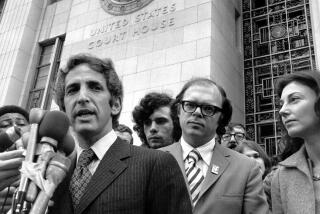Gen. Patton’s loot
THE METROPOLITAN Museum of Art in New York and the Getty Center in Los Angeles are facing charges of complicity in the acquisition of looted art. The objects in question are ancient artworks and artifacts, but loot can come from any time and any place.
Here in Los Angeles, you can check out some loot that dates to 1935: Original copies of the three Nuremberg Laws, signed by Hitler, including the infamous Blood Law, which signaled the beginning of the end for Jews under the Third Reich. They’re on display at the Skirball Cultural Center, courtesy of the Huntington Library.
The Huntington’s claim to ownership of the documents rests on the fact that they were a gift in 1945 from one of California’s homegrown heroes, Gen. George Patton. But, as it turns out, the documents are war loot, a prize that Patton knew wasn’t his to take or give and a piece of history whose own history needs to be officially cleaned up.
Wars are good for the business of looting, and the Nazis were infamous for appropriating valuables from defeated and victimized individuals. Today, the Los Angeles County Museum of Art unveils five paintings by Gustav Klimt that were stolen by the Germans from the family of Austrian-born Maria Altman, an L.A. resident who fought a seven-year legal battle to regain her family’s possessions.
The Nazis weren’t the only ones who took what didn’t belong to them. Collecting souvenirs, especially battlefield trophies, was common during World War II on all sides, even informally sanctioned. Former President Hoover had a man in Germany at the end of the war seeking documents for his War Library archives at Stanford. Rabbi Judah Nadich, Gen. Dwight Eisenhower’s advisor on Jewish affairs, took home a couple of swords belonging to Joseph Goebbels. But Patton acquired more than most people.
He began amassing souvenirs of war in 1916, when he sent his father the silver-mounted saddle and sword of Julio Cardenas, an officer in Pancho Villa’s army whom he had killed in Mexico. During World War II, he sent home German helmets, Nazi daggers, a Spanish cannon and a bronze bust of Hitler.
The general got his hands on the Nuremberg Laws near the end of the war, when a U.S. military intelligence team turned over to him what would turn out to be one of two surviving original copies. By then, Patton had been charged by Eisenhower with gathering Nazi documents for what would become the war crimes tribunal, so he had to know that the Nuremberg Laws were supposed to be sent to the Allies’ headquarters in Paris. Instead, he pocketed them for himself.
During a visit to California in June 1945, Patton made an unpublicized stop at the Huntington Library, where he deposited the Nuremberg Laws. He had grown up next door to the Huntington estate; his father and Henry E. Huntington were in business together, and Huntington had played a key role in getting young George into West Point in the early 1900s. Now, Patton showed off his trophy to his hosts and, in a statement dictated to a clerk, told them that of all his wartime souvenirs, “this is the important one.”
He also assured the Huntington that the Nuremberg Laws were his property, recounting a story about his troops fighting through the streets of Nuremberg to rescue the documents, then turning them over to their general in “a great public presentation.” Patton died in a car accident later in 1945, and “his” Nuremberg Laws were never formally accessioned by the library. For 54 years, internal records show, the prize remained off the Huntington’s books, in a bombproof vault reserved for its most valuable holdings.
That the library held the laws -- and that they had a doubtful provenance -- wasn’t a secret at the Huntington. In 1991, a senior curator reminded her supervisor in a memo that the typescript pages “seem pretty clearly to be war loot.” But officials kept that to themselves when they finally revealed their possession on June 26, 1999, and announced the loan to the Skirball.
Why hadn’t the laws been displayed? Because “we were focused on other areas of interest,” officials told the L.A. Times. As for ownership, the article explained: “After the war, soldiers commonly took possession of historical and material goods from liberated territories.”
My co-researcher, Cecilia O’Leary, and I happened to be visiting fellows at the Huntington during this momentous event. Responding to information from a colleague at the National Archives, we tracked down then-83-year-old Martin Dannenberg, the officer in charge of the unit that had retrieved the Nuremberg Laws at the end of the war. According to Dannenberg and to records left by his interpreter, Frank Perls, the L.A. art dealer, they were found in a vault in Eichstatt, a town near Nuremberg, in late April 1945, not early March, as Patton told the Huntington in his statement. Moreover, the soldiers were acting on a tip, not during the heat of battle, as in Patton’s bogus story. No record of the public presentation he alleged took place “about the 27th of May” in 1945 has ever been located.
So what should be done about this particular case of looting? In the absence of claims of ownership -- which might come from the U.S. or German governments -- the Huntington’s possession of the Nuremberg Laws prevails for the moment. And the documents’ display at the Skirball, which is a center of Jewish cultural life, carries a certain symbolic justice.
As Dannenberg says, it’s good that “the documents are now in a place where they will be seen by an understanding public.” Yet the Huntington, which rarely loans its materials, should also consider his diplomatic recommendation: “I am sure other museums will want to borrow them in the future, and I hope, because of their importance and what they represent, that they can be temporarily loaned to other responsible institutions.”
As important, the Huntington should come clean publicly about the full story of the Nuremberg Laws’ provenance. After all, the ownership of iconic objects, who possesses them, how they got them and why provides crucial context that is a mainstay of scholarship and public history.
Seeing the laws today is a powerful reminder of the evil governments can do. And in the case of this long-hidden artifact, we also learn something else: the way a trusted institution can cover up a war hero’s transgressions.


